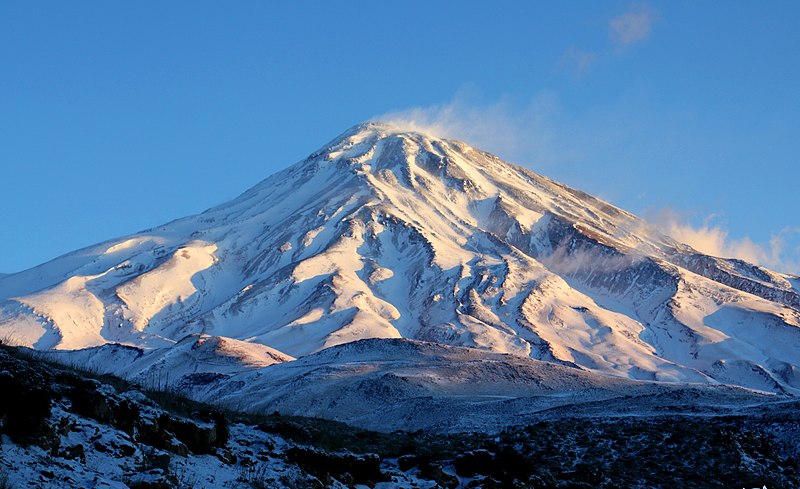Facts for Kids
Mount Damavand is a magnificent dormant stratovolcano located in Iran, standing at 5,609 meters, making it the highest volcano in Asia and a popular spot for hikers and nature lovers.
Overview
Geological Formation
Cultural Significance
Historical Expeditions
Local Myths And Legends
Tourism And Accessibility
Ecosystem And Biodiversity
Volcanic Activity And Risk
Climate And Weather Patterns
Climbing And Outdoor Activities
Research And Monitoring Efforts

Inside this Article
Persian Literature
Mount Damavand
Climate Zones
Mountain
November
Weather
Ecology
Camping
People
Risk
Did you know?
🌋 Mount Damavand is a dormant stratovolcano, which means it hasn't erupted for a long time but could sometime in the future.
🗻 It is the highest peak in Iran at 5,609 meters, making it the tallest volcano in Asia!
🌍 This majestic mountain is located in Iran, a beautiful country in Western Asia.
🔥 Mount Damavand was formed by volcanic activity millions of years ago.
🌿 The mountain is home to more than 800 different species of plants and animals!
🐑 Animals such as the Persian gazelle and mouflon can be found in the area around Mount Damavand.
🏞️ The most popular climbing route starts from the northern side of the mountain.
⏳ It takes approximately two to three days to reach the summit of Mount Damavand.
🇮🇷 Mount Damavand is mentioned in ancient Persian literature, symbolizing strength and endurance.
🌌 There are fascinating myths about a giant named Zal and his son Rostam that are connected to Mount Damavand.
Introduction
It’s part of the Alborz mountain range and is shaped like a giant cone. Mount Damavand is considered a dormant stratovolcano, which means it hasn’t erupted in a long time but could someday! People love to visit and enjoy its amazing views, making it a popular place for hiking and adventure 🤸♀️.
Geological Formation
It’s made of layers of lava that built up over time. The mountain is mostly made of a type of rock called basalt, which is formed when hot lava cools down quickly. The mountain also has a special feature called fumaroles, which are holes in the ground where steam and gases come out. This shows that there’s still some heat beneath the surface! 🌡
️ Cool, right? Scientists classify it as a stratovolcano because of its layered structure and steep slopes.
Cultural Significance
In these stories, the mountain is sometimes seen as a symbol of strength and endurance. Many locals also believe that Damavand is a place where good spirits reside. People often visit to feel connected to their heritage and enjoy nature’s beauty! 🌈
Historical Expeditions
The first recorded ascent was made by a traveler named “Hussein Fasham” in 1950. Since then, many climbers and mountaineers have shared their experiences and stories! 📚
These expeditions helped people understand the mountain better and connect with nature. Climbing Damavand is not just a hike; it’s a journey through history and adventure! ✨
Local Myths And Legends
One popular story tells of a giant named “Zal” and his son “Rostam,” who lived in this beautiful region. According to the legend, Rostam fought demons on the mountain, showing bravery and strength. 🥇
The mountain is also believed to have magical powers and is sometimes called the “guardian” of the people. Local myths like these inspire people to treasure the history and wonder of Damavand! 📖
Tourism And Accessibility
️ The region around it is well-known and has plenty of facilities for visitors. People can find local guides, hotels, and restaurants near the mountain. The best time to visit is during spring and summer when the weather is mild. Many tourists come from places like Europe and Asia to hike and enjoy the stunning views! 🚶
♀️ If you want to experience the magic of Damavand, plan your trip ahead of time! 📅
Ecosystem And Biodiversity
Over 800 different types of plant species grow here, with some found nowhere else in the world! There are cute animals like the Persian gazelle and the wild sheep called the mouflon. 🐑
The mountain has different climate zones, meaning that you can find different plants and animals at different heights. The lower slopes have lush greenery, while the higher areas are rocky and colder. It’s a special place for nature lovers and researchers! 🌼
Volcanic Activity And Risk
Scientists keep a close eye on it to check for any signs of activity. They use special tools to monitor temperatures and gases near fumaroles. While it’s considered low risk, students should still understand that volcanoes can sometimes surprise us! 📊
Being alert and knowledgeable about these changes helps keep everyone safe!
Climate And Weather Patterns
️ At lower altitudes, it’s warm and sunny, but as you go higher, it gets much colder and windier! 🥶
The mountain gets snow from November to May, making it perfect for winter sports! ❄
️ The best time to climb is during the summer when temperatures are milder. However, always be prepared for sudden weather changes! 🌦
️
Climbing And Outdoor Activities
♂️ Many people from all around the world come to hike its trails. The most popular route starts from the northern side, where climbers can reach the summit in two to three days! ⏳
It’s not just about climbing; visitors also enjoy camping and photographing the breathtaking views. During the summer months, the weather is perfect for outdoor fun! Just make sure to have the right gear and follow safety rules! ☀
️
Research And Monitoring Efforts
They observe the plants, animals, and geological formations to understand how the environment functions. Researchers also keep track of any changes in volcanic activity to ensure safety for visitors and locals. 🕵
️♀️ By studying this majestic mountain, they help protect its beauty for future generations! 🌍

